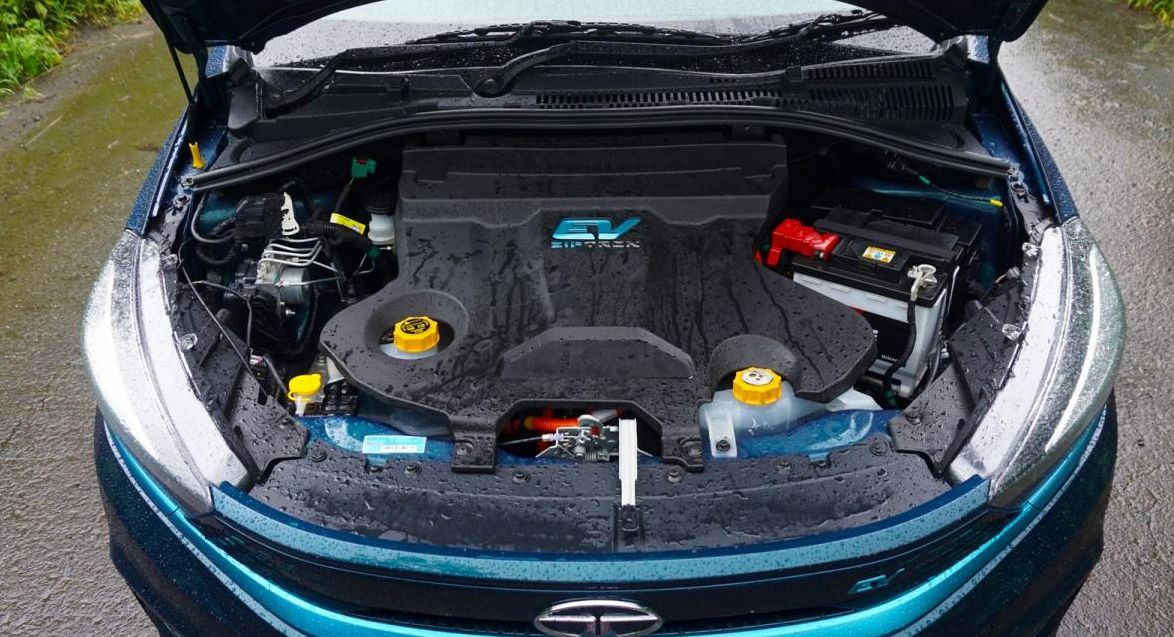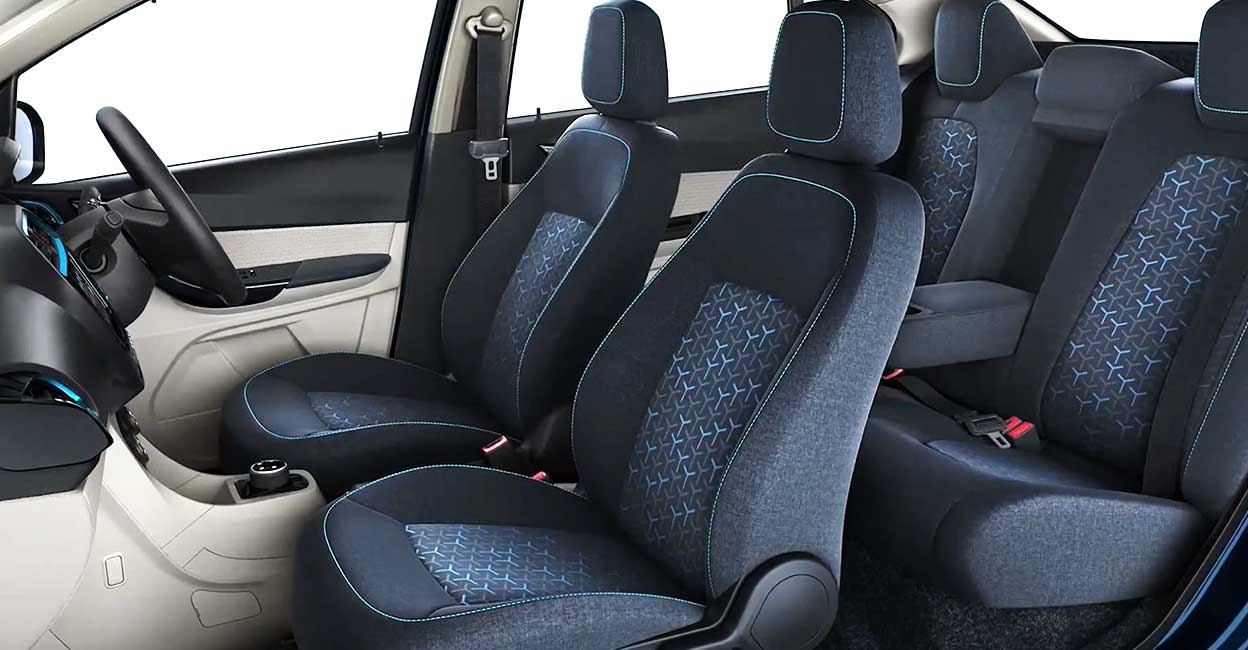

Latest Update: The newly launched Tata Punch EV is Tata's first EV model to be underpinned by the brands newly developed pure EV only architecture - Acti.ev. Moreover, the next generation of Tiago EV and Tigor EV too are likely to be based on Tata's new Acti.ev architecture.
Introduction
Tata Tigor EV is currently the only mass market electric sedan available in India. Just like Tiago EV and Nexon EV, Tigor EV was also designed and developed by modifying the chassis of its ICE counterpart. Basically it was developed by modifying and converting the ICE Tigor to support electric powertrain.
Exterior and Design
In the exterior, Tata Tigor EV gets miniscule difference compared to its ICE counterpart i.e. the petrol engine powered Tigor. The main difference between the two lies only in the front grille, the blue accents, the EV badging and the different design wheels.
Interior and Features
Being an EV, it gets more features and tech than its ICE counterpart. Some of these features include Z-Connect connected car tech, auto headlamps, rain sensing wipers, push button start, cruise control, rear central armrest etc.
Battery & Motor
Tata Tigor EV comes with a 26 kWh high density battery pack and an electric motor that produces 74.7 PS of power and 170 Nm of torque.
Drive Train
Tata Tigor EV is a front wheel drive electric sedan.
Driving Range
The ARAI certified range of Tata Tigor EV is 315 km on a single full charge. Moreover, it comes with both AC charging for home use and DC fast charging support.
Dimension
On the dimension front, the Tata Tigor EV measures 3993 mm in length, 1677 mm in width, and 1532 mm in height. The wheelbase of Tigor EV stands at 2450 mm and its boot space measures 316 litres. The lower boot space is due to the spare wheel that is placed inside the boot because of the battery pack.
Variants and Colours
Customers can go with 3 different colours and can choose from 4 different variants of Tata Tigor EV.
Segment and Rivals
Tata Tigor EV rivals other electric hatchbacks like Citroen eC3, MG Comet EV and Tata’s own Tiago EV in the entry level electric car segment.
 |  |  |  |
| Tata Tigor EV | BMW XM | Maruti Baleno | Tata Tiago EV |
| ₹ 12.49 - 13.75 Lakh | ₹ 2.60 - 2.60 Cr | ₹ 6.70 - 9.92 Lakh | ₹ 7.99 - 11.14 Lakh |
Rating | |||
4.1/5 | 0/5 | 4.1/5 | 3.8/5 |
Battery Capacity | |||
| 26 kWh, Lithium Ion,Battery Placed Under Rear Seats | 25.7 kWh, Lithium Ion, 317 Volt,Battery Placed Under Floor Pan | - | 19.2 kWh, Lithium Ion,Battery Placed Under Rear Seats |
Airbags | |||
| 2 | 6 | 2 - 6 | 2 |
Range | |||
| 315 Km/Charge | 0 Km/Charge | 0 Km/Charge | 223 - 315 Km/Charge |
Max Power(bhp@rpm) | |||
| NA | 644 bhp @ 5400-7200 rpm | 88 bhp @ 6000 rpm | NA |
Fuel Type | |||
| Electric | Plug-in Hybrid (Electric + Petrol) | Petrol | Electric |
NCAP Rating | |||
| Not Tested | Not Tested | Not Tested | Not Tested |
Transmission | |||
| Automatic | Automatic | Manual / Automatic | Automatic |
| Currently Viewing | Tigor EV vs XM | Tigor EV vs Baleno | Tigor EV vs Tiago EV |

The Tata Tigor EV's electric motor and battery mix allow it operate effectively as an EV. The setup is excellent, and the Tigor EV's motor allows it to smoothly navigate city traffic.
The most important modification in the Tigor EV is the adoption of Ziptron technology. A bigger 26kWh liquid-cooled lithium-ion battery with an ARAI certified range of 306km is available on a single charge.
This is a huge improvement over the previous model, and those who suffer from range anxiety will find this vehicle more manageable. Longer battery life translates to faster charging times.
Tata says that if you use a 25kW fast charger, you can charge the car from zero to 80 percent in just 25 minutes. This is achieved at a temperature of 25 degrees Celsius, while the charging time increases only little if the temperature goes to 30 degrees or higher.
The car also has a charger that is compatible with ordinary 15-amp residential outlets. According to the manufacturer, this charger will charge your phone to 80% in 8 hours and 45 minutes. The first and most noticeable aspect of the new Tigor EV's powertrain is how smooth and linear it is.

The usual drive mode is appropriate for ordinary city use and will suffice in most scenarios. The Tigor EV comes in three variants: XE, XM, and XZ+, with prices starting at Rs 11.99 lakh ex-showroom. This base pricing isn't especially excellent value, though, because the standard edition lacks a number of critical functions.
On the one hand, it has modern features like climate control, a digital instrument display, and LED taillights, yet it lacks basic features like rear power windows, alloy wheels, and even a music system. According to my calculations, the top-spec XZ Plus is the most cost-effective option.
Push-button start, a superb Harman audio system, a cooled glove box, driver's seat height adjustment, a rear parking camera, a rear armrest, auto folding wing mirrors, and more are all included.
When you consider that the entry-level Nexon EV is a few lakh more expensive, but you get a lot superior electric car, the Tigor EV's value proposition is put to the test once more.
It is, however, significantly lighter than the Nexon, which may result in a greater real-world range between the two. The smaller Tigor EV will, of course, be easier to drive and park around town, and there is currently no better budget car for those looking to make the switch to EVs.

When you look at the new Tigor EV, you'll note that it looks prettier than before, despite the fact that it hasn't changed much. The chrome line beneath the grille and headlights, as well as the chrome bezel on fog lamps, have been replaced with blue components.
Unfortunately, the vehicle still lacks LED headlights and is outfitted with halogen projector illumination. The new bumper has LED DRLs with fog lights and a tri-arrow pattern. The EV badge can be located on the grille, sides, and rear of the vehicle.
The ordinary Tigor's top grade features 15-inch wheels, but this one sports 14-inch X-shaped ones with blue accents. The Tigor EV's general appearance and design are identical to that of its ICE-powered sister. Tata has cleverly included a tiny boot at the rear of the Tigor EV.

Even inside, the changes are subtle, with blue touches throughout the cabin. The chairs' darker stitching contrasts wonderfully with the blue accents.
Black seats have the advantage of being more difficult to stain than white seats. The upper part of the dashboard and door panels are darker than the lower half, which is almost cream-colored. You'll get a kit that's nearly identical to what you'd find in a regular Tigor.
A 7.0-inch touchscreen infotainment panel with Android Auto and Apple CarPlay connectivity is offered. It also comes with 35 connected car features, such as vehicle metrics on your phone, remote start, geo-fencing, and more. They may be handy when aiming to conserve money when driving.

A smaller one is available for the middle passenger, however it is only ideal for children or little persons. Because the floor is mostly level, this vehicle can carry three passengers more easily than others. The general quality of the interior is similar to that of other Tata vehicles. The spacious interior is nicely supported with plenty of useable space for the passengers.

Tata is well-known for producing some of the safest vehicles in the country. Tigor EV is also not a surprise because it is a well-built vehicle. Electronic Stability Control, side-impact avoidance, and three-point belts in all sitting positions, among other technologies, can improve the safety rating of an electric car.
The Tata Tigor EV, the first electric vehicle (EV) to be tested by Global NCAP, achieved four stars for both adult and child occupants in the most current crash testing. The electric car was examined under the #SaferCarsForIndia campaign in its most basic safety specification, which includes two airbags as standard.
Additional safety features such as Electronic Stability Control (ESC), side-impact protection, three-point belts in all seating positions, and ISOFIX connectors, according to the safety rating agency, can raise the electric vehicle's safety rating.

TELCO DNA is present in every Tata vehicle, as demonstrated by the Tigor EV.
The Tigor EV has an outstanding ride since the good suspension setup quickly absorbs the majority of the undulations. This car supports regenerative braking, and as previously indicated, an indicator on the right side of the instrument cluster indicates the amount of regen braking done.
While the regen braking amount cannot be changed, the default value suffices. Testing. Dual airbags, reverse parking sensors, ABS, and EBD are all standard equipment. Aside from that, there's a rear parking camera and hill climb and descent control.

















































I had purchased tata tigor ev one month ago. It is very nice range in terms of safety , performance, looks and many more. I had purchased this car in 12 lakhs. It has battery capacity of 26 kwh in which it gives driving range of around 315 km per full charge. It also supports the fast charging function which take 2 hrs for 0-80 percent charge. Normally it takes around 7 hrs for full charging.
I had recently purchased the tata tigor ev. I am very happy with the car as it gives the best performance. I always like the cars of tata and the performance it delivers. It has a fine range of 300 kms and charging tme of 9.4 hrs. Overall nice car.
Lets be honest, we have all thought about buying an ev. But with the high purchase cost, its hard to trust a technology. We need a safer first step which could be the tata tigor ev. The tata tigor ev is the most affordable electric car you can buy in the country which gives an amazing range of 315 kms.
Tata Tigor EV offers a range of 315 km/charge.
Tata Tigor EV starting price is 12.49 Lakh (plus registration, insurance & other costs) for the base model. while the Tata Tigor EV top model price is Rs.1349000 (plus registration, insurance & other costs).
Click Here to check OnRoad Price ofTata Tigor EV.